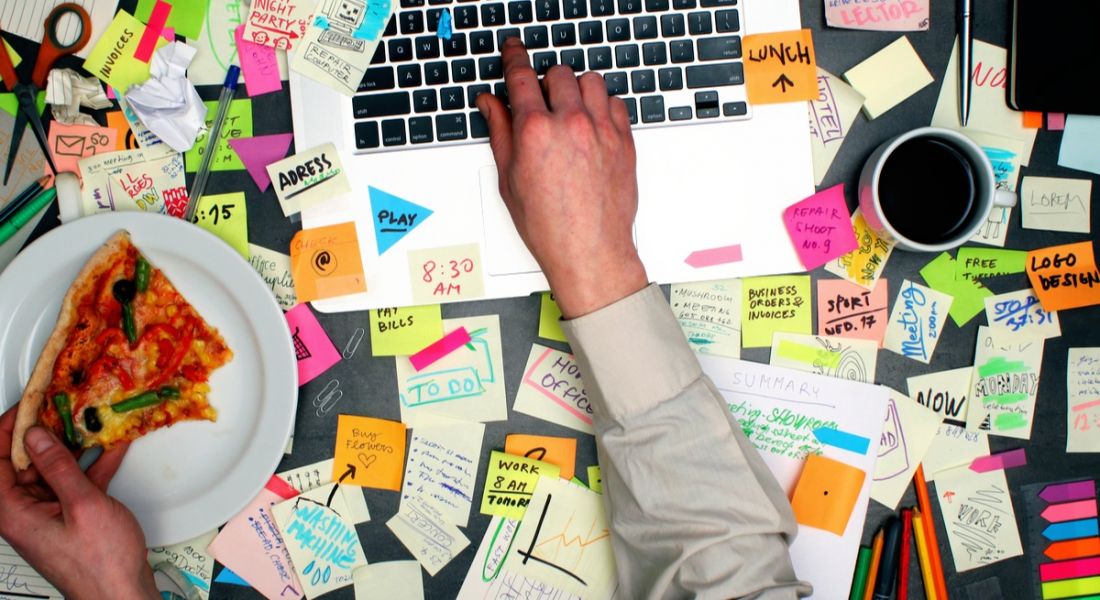Admit it, you have lost control of the situation at this stage. Here’s how you can clean up your act (and your desk).
Envision the scene. You return to work after a restorative weekend on a Monday morning with high hopes of getting the week off to a happy and productive start, only to be greeted by the hell with which you have become all too familiar: your incredibly messy workspace.
The edges of your computer screen are obfuscated with crumpled Post-its. A fork crusting with detritus from a meal you ate three weeks ago is propped against your work landline along with the withered, plastic husk of a tissue packet. There are business cards strewn about like autumn leaves below an oak tree.
Don’t even get me started on your desk drawers. The top one has been rendered into a miasma-spewing hellhole because you left some weird snack in there months ago and now you’re too scared and ashamed to look at what you’ve done. You just avert your gaze whenever you reach in for something and pretend that your hand isn’t grazing an unctuous mass every time you grab your yellow highlighter.
If this all sounds familiar, you need to accept that you’ve officially lost control of your office space. You don’t own the desk – the desk owns you now.
Why should you bother cleaning it?
But maybe you don’t mind your desk being messy, so why should you clean it?
For one, you’re kidding yourself if you think you’re maintaining optimal organisation without any kind of system. One of those aforementioned business cards could contain important information or the email of a much-needed contact. You’re making it harder for yourself to keep track of things and, by extension, harder for you to bring your best self to work.
Perhaps you are naturally a little more disorganised, but you have found a way to navigate your desk and keep on top of things. Why bother changing?
Well, it probably doesn’t create a great impression of your professional competency if your desk looks like a tornado hit it. It may seem a little unfair that someone would make that kind of snap judgement based on something that is arguably superficial, but it can and does happen. You wouldn’t want to wear a creased or stained outfit to a job interview – this is, in some way, an extension of that.
Even if you’ve gotten to know your co-workers, people you still need to impress, such as clients, could still pass through your workspace.
The open plan architecture that is now so common in the working world means your desk is much more on display than it would have been in times gone by.
So, let’s say you’re convinced. What can you do?
Do you actually need all of this stuff?
The first step to getting a handle on your desk situation is to take a look at all the stuff you’re currently hoarding and ask yourself if you honestly need to keep all these things.
Bestselling Japanese author Marie Kondo has professed that you should only keep things that are totally necessary or bring you joy. Everything else, Kondo argues, should be “touched, thanked and sent on its way”.
So, pick up that memo from a meeting in 2014, thank it for its years of service and send it to your nearest recycling bin. Pick up every item on your desk and ask yourself if it’s actually necessary.
It’s possible you’re keeping documents that contain important information, yet that doesn’t mean you have to keep a soft copy. Scan those papers, store those digital files in your Dropbox or Google Drive, and say goodbye to the needless clutter.
Get a desk organiser
You need to segment the expansive space both on top of your desk and inside your drawers. The best way to do that is to get your hands on a desk tidy – they’re pretty widely available in places such as Eason’s, IKEA and Muji, to name a few. A letter or magazine file can also be great for storing documents.
Having organisers makes it easier to assign a place for everything, and this will help prevent your desk from returning to its state of total entropy. If you know that pens go in one box and your stapler goes somewhere else, it’s both easy to find things and tidy them away afterwards.
Set aside time in your work day
Maintaining your desk to a professional standard should feel like a part of your work day and you should pencil it into your schedule as such.
The last half hour of your day should be reserved for admin-type activities. Starting other tasks so late in the day will only make it likely that you accidentally stay late. Doing things such as tidying your desk and making tomorrow’s to-do list makes it easier to get out the door on time as well as leave you feeling confident that you’ll be able to dive into the next working day prepared for whatever challenges it may bring.
You can set a weekly reminder in Slack or in your email to disinfect the desk surface. This is particularly important if you count yourself among the large cohort of people who eat their lunches at their desks. This is a habit you should try to break where possible but, in the interim, at least make sure you’re keeping your desktop/dining table clean.




